Wasp Control Solutions – Safe & Effective
Wasps are flying insects belonging to the order Hymenoptera, which includes over 100,000 species worldwide. They are characterized by their slender bodies, often with bright yellow and black markings, although some species may have different coloration. Wasps play important roles in ecosystems as both pollinators and predators of various insects, including pests. While some species are solitary, many live in colonies, with social wasps like yellowjackets and hornets being more well-known for their communal behavior. Wasps are equipped with stingers that they use for self-defense and capturing prey, and their presence can be beneficial but also pose a nuisance to humans, especially during the warmer months.
The different species of wasp
The most common species of wasps can vary by region and habitat, but some of the most widely encountered and well-known species include:
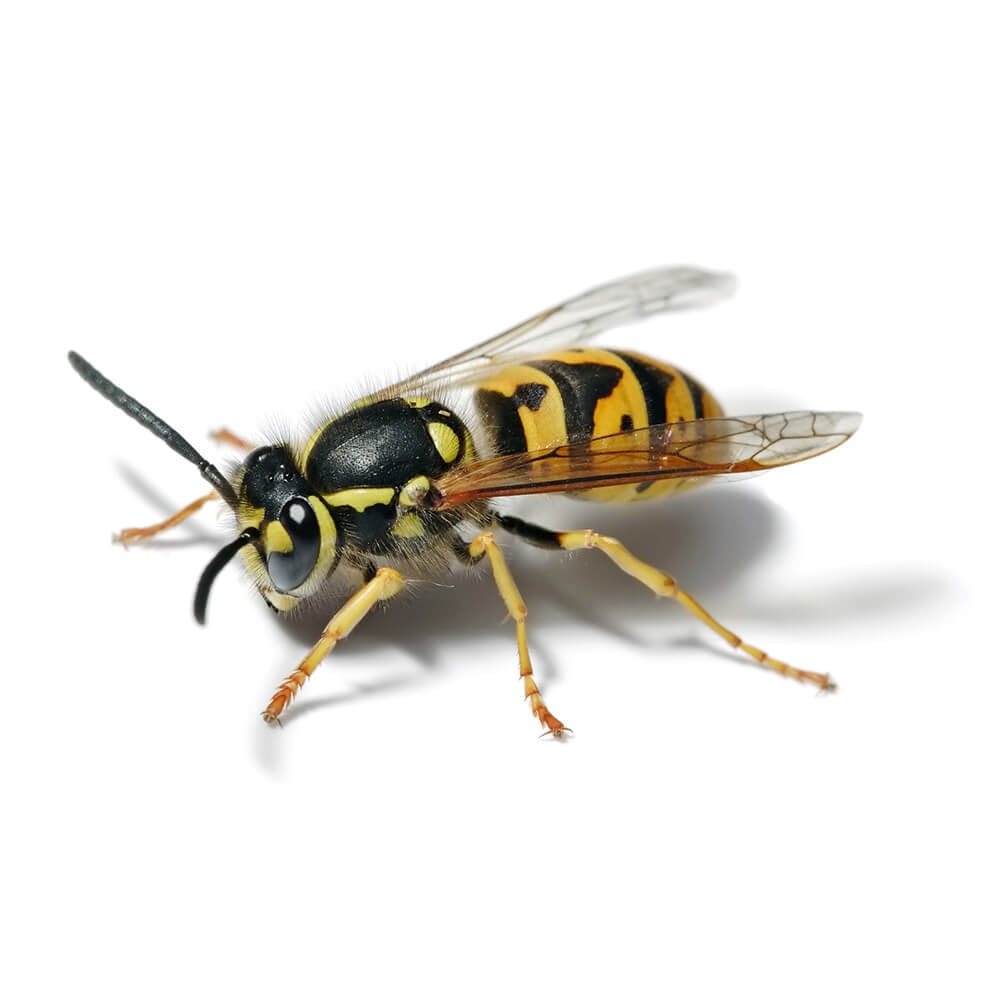
Yellowjackets (Vespula spp. and Dolichovespula spp.)
Yellowjackets are known for their distinctive black and yellow markings and are often encountered at picnics and outdoor events, where they are attracted to sugary foods and beverages. They build paper nests underground or in cavities.
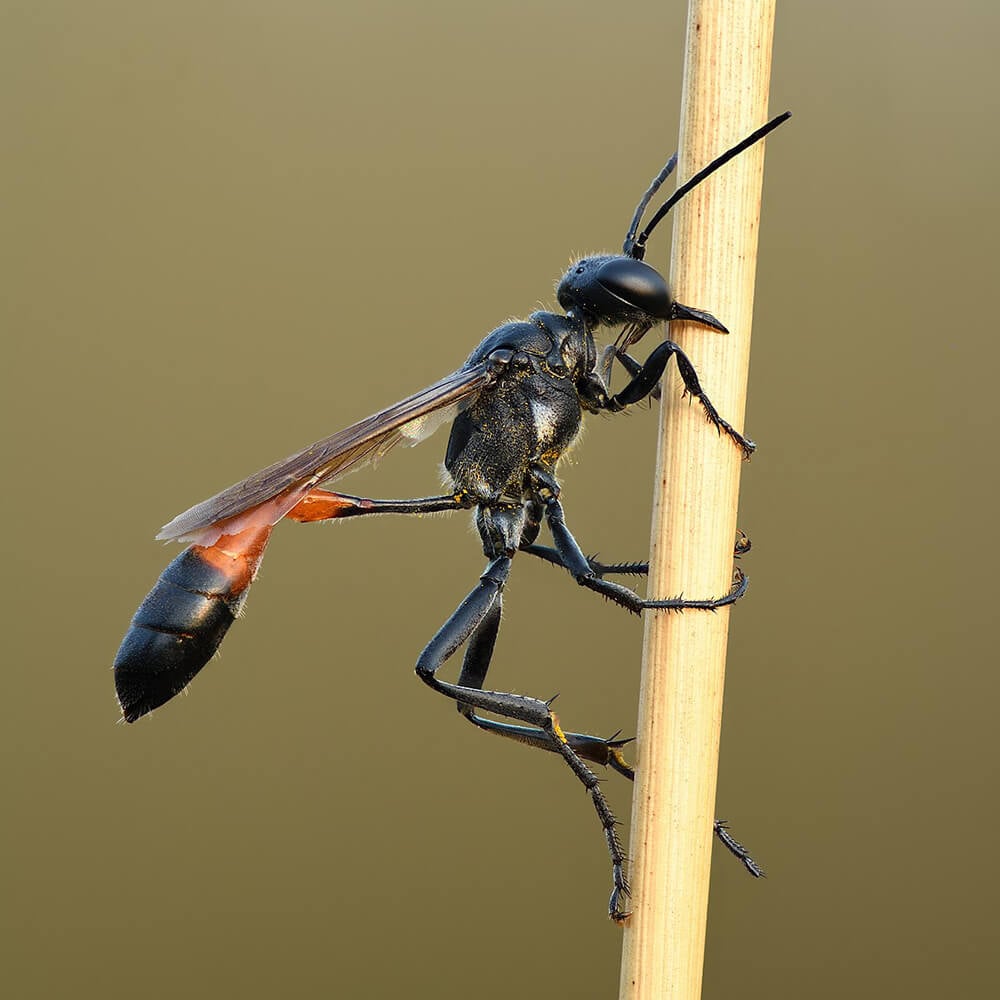
Mud Daubers (Sphecidae family)
Mud daubers are solitary wasps that build nests from mud, often on the sides of buildings or other structures. They are not usually aggressive and are beneficial for controlling spider populations.

Paper Wasps (Polistes spp.)
These wasps are known for their distinctive papery nests, which are often attached to the eaves of buildings or tree branches. They tend to be less aggressive than yellowjackets.
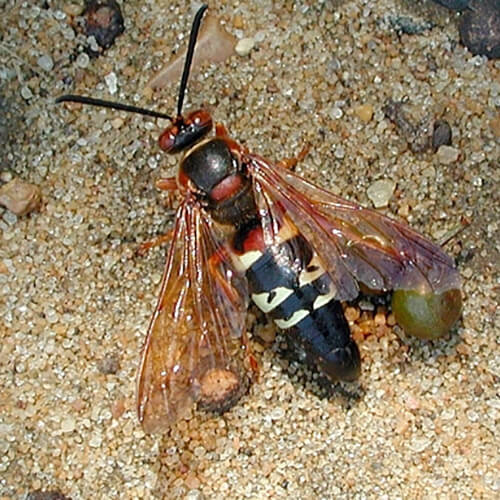
Cicada Killers (Sphecius speciosus)
These large wasps are known for capturing and paralyzing cicadas to provision their underground nests. They are generally not aggressive toward humans unless provoked.
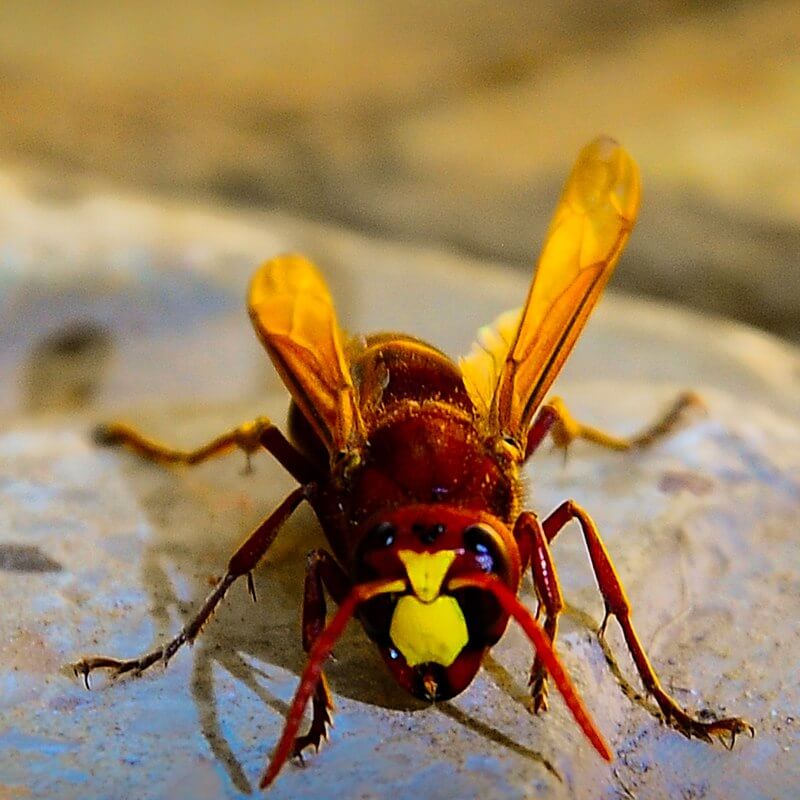
Hornets (Vespa spp.)
Hornets are larger than most other wasps and are known for their potent stings. They construct large, enclosed paper nests, typically high in trees.

Baldfaced Hornets (Dolichovespula maculata)
These hornets are known for their striking black and white coloration and build large paper nests in trees or shrubs.
It’s important to note that there are thousands of wasp species worldwide, and their behavior and appearance can vary significantly. While some species are beneficial as pollinators and natural pest controllers, others can be more aggressive and may pose a nuisance or danger to humans.
There are over 100,000 known species of wasps, and scientists estimate there may be hundreds of thousands more undiscovered species.
The life cycle of wasp
The life cycle of a wasp is a fascinating journey, marked by distinct stages of development. Wasps, like other insects, go through a process called metamorphosis, which consists of four main phases: egg, larva, pupa, and adult.

Egg Stage
The life cycle begins when the adult female wasp lays eggs. She carefully selects a suitable location for her offspring, often within a protected nest. The number of eggs can vary depending on the wasp species. Once laid, the eggs require warmth and protection to develop.

Pupal Stage
After a period of growth and development, the larva spins a protective cocoon around itself, entering the pupal stage. Inside this cocoon, significant changes occur as the larva undergoes transformation. This phase can be compared to a caterpillar transforming into a butterfly. The pupa develops wings, antennae, and other adult features.
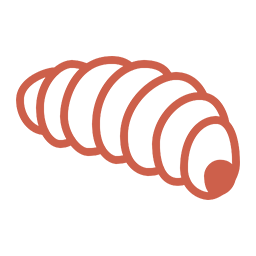
Larval Stage
Upon hatching from the eggs, wasp larvae emerge. During this stage, the larvae are typically worm-like in appearance and lack wings or other distinguishing features. They are entirely dependent on adult wasps for nourishment. Adult wasps feed the larvae a diet of insects, spiders, or other prey, providing them with essential nutrients for growth.
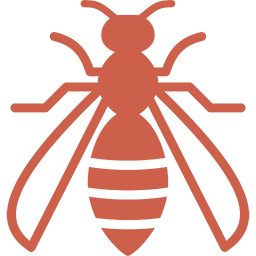
Adult Stage
Finally, the fully developed adult wasp emerges from the cocoon. This stage is marked by the wasp’s characteristic appearance, complete with wings and a slender body. Adult wasps play crucial roles in pollination and, in some species, social behavior within colonies.
The duration of each stage in the life cycle can vary depending on environmental conditions, such as temperature and food availability, as well as the specific species of wasp. Once mature, adult wasps may live for several weeks to a few months, during which they contribute to their ecosystem through various behaviors, including pollinating plants and controlling insect populations. Understanding the life cycle of wasps is essential for appreciating their role in nature and their interactions with the environment.
Some wasps are parasitoids, meaning they lay their eggs inside other insects or arachnids. The wasp larvae consume the host from the inside, eventually killing it.
The seasons most conducive to wasp
Wasps are most active and thrive during the warmer seasons of spring, summer, and early fall. These seasons provide the ideal conditions for their life cycle and behavior:
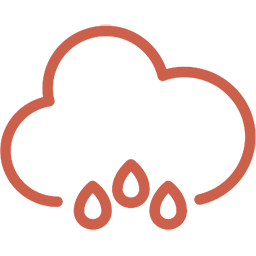
Spring
As temperatures begin to rise in spring, wasps become more active after a period of dormancy during the winter. Queen wasps that overwintered emerge from their hiding places and start new colonies. They seek out suitable nesting sites and lay the initial batch of eggs. During this season, their focus is on establishing and expanding their nests.
Summer
Summer is the peak season for wasp activity. With ample sunlight and warmth, colonies grow rapidly. Worker wasps emerge from the eggs laid in the spring and take on the tasks of foraging for food and defending the nest. Wasps are frequently seen scavenging for nectar, pollen, and other food sources. The abundance of flowers and flowering plants during summer provides a consistent food supply.
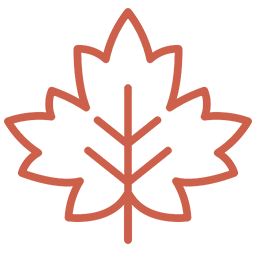
Early Fall
In early fall, wasp colonies continue to expand and reach their maximum size. The weather remains warm, allowing the wasps to be active. During this time, new queens and male wasps are produced, and the colony prepares for the upcoming winter. Nectar and other sugary foods become increasingly important as the colony focuses on building up reserves to survive the colder months.
While wasps are most conducive to the aforementioned seasons, their behavior can vary depending on the specific species and local climate. In cooler regions, wasp activity may decline as temperatures drop in late fall and winter, with many colonies not surviving the cold. It’s also important to note that the presence of food sources, shelter, and environmental conditions can influence their behavior and activity levels. Understanding the seasonal patterns of wasps is valuable for managing and coexisting with them, especially during their peak activity in spring and summer.
In colder climates, the majority of a wasp colony does not survive the winter. Only the newly fertilized queens survive by finding sheltered locations to hibernate until spring, when they start new colonies.
Where do wasp come from, their habitat
Wasps originate from a wide range of habitats, and their specific origins depend on the species. However, here is a general overview of where wasps typically come from and their habitats:

Natural Habitats
Many wasp species have evolved to thrive in natural environments. They can be found in forests, meadows, grasslands, and wetlands. Within these natural habitats, they often nest in protected areas like tree hollows, underground burrows, or the branches of shrubs and trees. These nests are constructed from materials such as wood fibers or mud, depending on the wasp species.

Agricultural Settings
Certain wasp species are beneficial to agriculture because they prey on crop-damaging insects. They can be found in agricultural fields and orchards where their presence helps control pest populations. In these environments, they may build nests in sheltered locations or in vegetation.

Water Sources
Some wasps are attracted to water sources, such as ponds or streams, where they drink and forage for insects near the water’s edge. They may also build nests in nearby areas.

Urban and Suburban Areas
Wasps are highly adaptable and have successfully colonized urban and suburban environments. They often build nests in and around human-made structures such as houses, sheds, and garages. Eaves, roof spaces, and wall voids are common nesting sites for some species. The availability of food sources, including human food and garbage, makes urban areas attractive to wasps.

Gardens and Parks
Gardens and parks provide a variety of flowering plants, which attract wasps looking for nectar and pollen. In these areas, you might encounter different wasp species foraging for food. Some solitary wasps also find suitable nesting sites in gardens, often in the soil.
It’s important to note that there are thousands of wasp species worldwide, each adapted to specific ecological niches and habitats. While some wasps are solitary and build individual nests, others are social and live in colonies. Their habitat preferences can vary widely, and their behavior may be influenced by environmental factors such as climate, food availability, and the presence of suitable nesting sites. Understanding these factors is essential for effective wasp management and conservation efforts.
Social wasps are known for building paper nests. They create these nests by chewing up wood or plant fibers and mixing them with saliva to create a pulp, which they then shape into nests.
What attracts wasp into our homes
Wasps can be attracted to our homes for various reasons, often related to the availability of food, shelter, and suitable nesting sites. Here are some factors that can draw wasps into residential areas:
Food Sources
- Sugary Foods: Wasps are attracted to sweet substances like fruit juices, soda, and sugary snacks. Open beverage containers and exposed food can lure them in.
- Protein: Some wasps are carnivorous and are attracted to protein sources like meat, fish, and pet food left outdoors. They may scavenge around outdoor dining areas.
Water Sources
- Pools and Birdbaths: Wasps are drawn to water for drinking. Swimming pools, birdbaths, and dripping faucets can serve as water sources that attract them.
Odors and Scents
- Strong Odors: Unpleasant odors, such as rotting fruit, can attract scavenging wasps searching for decaying matter.
Garbage and Food Waste
- Trash Bins: Overfilled or uncovered trash bins can emit strong odors that attract wasps. They may forage on discarded food items in the trash.
Nesting Opportunities
- Structural Gaps: Wasps often search for sheltered places to build nests. They may enter homes through gaps, cracks, or openings in walls, roofs, or eaves.
- Eaves and Roof Spaces: Certain species, like paper wasps, may construct nests under eaves, in attics, or in wall voids, making homes convenient nesting sites.
Bright Lights
- Light Sources: Some wasp species are attracted to bright lights during the nighttime. They may swarm around outdoor lighting fixtures.
Floral Gardens
- Flowers: Gardens with a variety of blooming flowers can attract wasps that seek nectar and pollen. While their presence can benefit pollination, it may also lead them closer to homes.
Warmth and Shelter
- Seasonal Changes: In cooler seasons, wasps may seek shelter indoors to stay warm. They may enter homes through open windows, doors, or gaps in search of warmth.
It’s important to take preventive measures to minimize the attraction of wasps to your home. This includes keeping food and trash containers tightly sealed, repairing any structural openings that may serve as entry points, and considering the placement of floral gardens and outdoor lighting. If you notice a significant wasp presence or a nest on your property, it’s advisable to seek professional pest control assistance for safe removal and management.
Most wasps are carnivorous and feed on insects, spiders, and other small creatures. They are crucial for controlling pest populations in ecosystems.
Signs that you have a wasp’ infestation
Recognizing the signs of a wasp infestation is crucial for prompt and safe removal. Here are common indicators that you may have a wasp infestation on your property or inside your home:
Increased Wasp Activity
A sudden increase in wasp sightings around your property, especially near specific areas like eaves, rooflines, or walls, may indicate the presence of a nest nearby.
Presence of Worker Wasps
If you see worker wasps regularly entering and exiting a specific location, it’s a strong indication of a nearby nest. Worker wasps are responsible for foraging and maintaining the nest.
Damaged or Discolored Wood
Wood damage or discoloration on the exterior of your home, especially in areas near potential nesting sites, could be a result of wasp activity. They may chew or bore into wooden structures.
Nest Materials Indoors
The discovery of nest materials like chewed wood, mud, or paper inside your home is a clear sign that wasps are nesting indoors.
Nests
Actual physical nests are one of the most obvious signs. Wasps build nests from materials like paper, mud, or chewed wood fibers. These nests can vary in size and location, from small, papery nests under eaves to large, complex nests within wall voids or attics.
Aggressive Behavior
Aggressive or defensive behavior from wasps, such as swarming, stinging, or buzzing aggressively around people or pets, may indicate that a nest is nearby, and they perceive a threat.
Presence of Larvae
In some cases, you may discover wasp larvae or pupae inside your home, indicating that a nest is nearby. Larvae are typically pale and worm-like.
Audible Buzzing
If you hear a consistent buzzing sound, especially within walls or ceilings, it could be a sign of an active wasp nest. Wasps can be noisy when they are active.
Chewed Wood or Plant Material
Some wasp species chew wood or plant material to construct their nests. If you notice small bits of chewed material or wood pulp around your property, it could be evidence of nesting activity.
Frequent Indoor Sightings
If you notice wasps frequently entering your home, particularly during colder seasons, they may have established a nest indoors.
It’s important to exercise caution when dealing with a suspected wasp infestation, as they can become aggressive when their nest is threatened. If you believe you have a wasp infestation, it is advisable to contact a professional pest control service to assess the situation, safely remove the nest, and implement effective control measures. Attempting to remove nests or control wasps without proper knowledge and equipment can be dangerous.
Wasps come in two main types: social and solitary. Social wasps, like yellowjackets and hornets, live in colonies with a queen, workers, and drones. Solitary wasps, like mud daubers and potter wasps, live alone and do not form colonies.
Rooms where wasp hide
Wasps can seek shelter in various rooms and areas within a home, especially if they are nesting indoors or trying to escape harsh weather conditions. Here are some common rooms and locations where wasps may hide:

Attics
Attics provide an ideal shelter for wasps, as they are often quiet, dark, and warm. Wasps may build nests in attics or find cracks and openings to enter.
Roof Spaces
In some cases, wasps may find their way into the space between the roof and the ceiling, where they can build nests and remain hidden.
Basements
While less common, wasps can occasionally find their way into basements, especially if there are openings or cracks in the foundation or walls.
Chimneys
Chimneys, especially those without proper caps or screens, can be entry points for wasps looking for a protected area to nest.
Wall Voids
The empty spaces between walls can be attractive to wasps for nest building. They can access these voids through small openings in the exterior of the house.
Crawl Spaces
Crawl spaces beneath the house can provide shelter for wasps. They may access these areas through gaps or openings in the foundation.
Windows and Doors
Wasps may enter the home through open windows or doors and seek shelter inside rooms.
Eaves and Soffits
Wasps often construct nests under the eaves or soffits of houses. These areas provide protection from the elements while allowing easy access to the outdoors.
Garages and Sheds
Wasps can establish nests in garages, sheds, and storage areas. They are attracted to these spaces due to the shelter they offer.
Indoor Plants
Sometimes, wasps are attracted to indoor potted plants. They may build small nests in the soil or seek refuge in the foliage.
It’s important to note that not all wasps hide in indoor spaces. Many species prefer outdoor nesting sites and only enter homes accidentally or foraging for food. If you suspect that wasps have nested indoors or are hiding in specific rooms, it’s advisable to seek professional pest control assistance for safe removal and proper control measures. Attempting to remove nests or wasps without the necessary knowledge and equipment can lead to stings and further infestations.
Many wasps have bright colors, such as yellow and black or red and black, to signal their presence and deter potential predators. These colors often serve as a warning of their ability to sting.
The dangers and damages that wasp can cause
Wasps can pose several dangers and cause various types of damages, making it essential to be cautious around them and take appropriate measures for control. Here are some of the potential dangers and damages associated with wasps:
Stings
Perhaps the most immediate danger posed by wasps is their ability to sting. Unlike honeybees, which typically sting only once, many wasp species can sting multiple times. For some individuals, wasp stings can cause severe allergic reactions, leading to anaphylaxis, a potentially life-threatening condition.
Aggressive Behavior
When wasps perceive a threat to their nest or colony, they can become highly aggressive and may swarm in defense. This aggressive behavior increases the likelihood of stings, posing a risk to anyone nearby.
Nest Damage
Wasps construct nests using a variety of materials, depending on the species. This can include chewing wood, using mud, or creating papery nests. The construction and expansion of nests can lead to structural damage in homes, sheds, and other buildings.
Disruption of Outdoor Activities
When wasp nests are present in outdoor areas like gardens or patios, they can disrupt outdoor activities. The fear of being stung can limit the enjoyment of these spaces.
Impact on Ecosystems
In some cases, invasive wasp species can disrupt local ecosystems by preying on native insects and affecting pollination dynamics.
Pain and Discomfort
Wasp stings are painful and can lead to localized swelling, itching, and discomfort, even in individuals who are not allergic. Multiple stings can exacerbate these symptoms.
Allergies
Allergic reactions to wasp stings can range from mild to severe. Symptoms may include difficulty breathing, swelling of the face and throat, hives, and a drop in blood pressure. Anaphylactic reactions require immediate medical attention.
Garden and Crop Damage
Some wasp species are known to damage gardens and crops by preying on pollinators or consuming plant sap. Their presence can harm agricultural yields.
Contamination of Food
Wasps are attracted to sweet foods and beverages. When they are present at outdoor gatherings or picnics, they can contaminate food and drinks, making them unsafe to consume.
Psychological Impact
The presence of a wasp infestation can create anxiety and fear for individuals who are allergic to stings or have had previous negative encounters with wasps.
Given the potential dangers and damages caused by wasps, it’s important to exercise caution around them and take steps to prevent infestations. If you suspect a wasp nest on your property or encounter aggressive wasp behavior, it is advisable to seek professional pest control assistance for safe removal and management.
While they are primarily predators, many wasp species also serve as pollinators. They visit flowers to feed on nectar and inadvertently transfer pollen from one flower to another.
How to get rid of wasp / Available treatments
Getting rid of wasps should be approached with caution to avoid stings and ensure effective removal. Here are some methods and available treatments for eliminating wasp infestations:
Professional Pest Control Services
- Highly Recommended: The safest and most effective way to remove wasp nests is to hire a professional pest control service. Pest control experts have the knowledge, experience, and protective gear to handle wasp infestations safely.
- Treatment Options: Professionals may use a variety of treatments, including insecticide sprays, dusts, or foams to directly target and eliminate the nest. They will also ensure that the entire colony is eliminated.
Remove Attractants
- Food and Garbage: Keep outdoor food and garbage containers tightly sealed to reduce the attraction of wasps.
- Fruit Trees: Regularly pick up fallen fruit from fruit trees, as ripe fruit can attract wasps.
Nest Relocation (if feasible)
- Caution Required: Some experts may relocate wasp nests to less populated areas if they are beneficial species. However, this should only be done by professionals with expertise in wasp behavior.
DIY Wasp Spray
- Caution Required: If you choose to use a commercial wasp spray, exercise extreme caution. Follow the instructions on the product label carefully, and wear protective clothing, including long sleeves, pants, gloves, and a face shield.
- Spray at Night: Wasps are less active at night, making it an ideal time to apply the spray directly onto the nest. Stand at a safe distance and aim for the nest’s entrance.
Seal Entry Points
- Inspect and Seal: Identify and seal any gaps, cracks, or openings in your home’s exterior, including eaves, vents, and rooflines, to prevent wasps from entering your living spaces.
Plant Selection
- Less Attractive Plants: Consider landscaping your garden with plants that are less attractive to wasps to reduce their presence in your outdoor spaces.
Wasp Traps
- Preventative Measure: You can set up wasp traps in your yard to capture foraging wasps. Commercial traps are available, or you can create your own using sweet baits or sugary liquids.
- Keep Away from Living Areas: Place traps away from outdoor living and dining areas to avoid attracting wasps closer to where people gather.
Professional Nest Removal
- After Treatment: Once a professional has treated the nest and ensured that the wasps are no longer active, they can safely remove the nest, if necessary, to prevent reinfestation.
Early Detection
- Regularly inspect your property for signs of wasp activity, such as nests, and address the issue promptly to prevent infestations from growing larger and more challenging to manage.
Remember that attempting to remove wasp nests without the necessary knowledge and protective gear can be dangerous, especially if you are allergic to stings. For your safety and effective wasp control, it’s advisable to consult with a professional pest control service.
Most wasps have stingers, and they use them for defense and capturing prey. Unlike honeybees, some wasps can sting multiple times.
How to prevent wasp infestations
Preventing wasp infestations involves taking proactive measures to make your property less attractive to these stinging insects. Here are steps you can take to minimize the risk of a wasp infestation:
Seal Entry Points
- Regularly inspect your home’s exterior for gaps, cracks, and openings, especially around eaves, rooflines, vents, and windows.
- Seal any openings with caulk, weatherstripping, or mesh screens to prevent wasps from entering your living spaces.
Maintain Outdoor Areas
- Keep outdoor dining and recreation areas clean and free of food scraps and crumbs.
- Regularly clean and maintain outdoor grills to remove food residue.
Select Wasp-Unfriendly Plants
- Consider planting flowers and shrubs that are less attractive to wasps, such as herbs like rosemary, mint, and basil.
- Avoid planting flowers with bright, sweet-smelling blooms.
Professional Prevention
- Consider hiring a professional pest control service to apply preventive treatments around your home’s exterior to deter wasp nesting.
Keep Food Secure
- Ensure that outdoor food and garbage containers are tightly sealed.
- Clean up food and beverage spills promptly, especially during outdoor gatherings.
Limit Sweet Scents
- Avoid using perfumes, lotions, or scented products with sweet floral or fruity fragrances when spending time outdoors.
- Limit the use of sweet-smelling candles or air fresheners in outdoor areas.
Regular Inspection
- Conduct regular inspections of your property to identify any early signs of wasp activity, such as nests or increased wasp presence.
- Address any nests you find promptly or consult with a professional pest control service.
Educate Family Members
- Teach your family members and children to be cautious around wasps and avoid disturbing their nests.
- Ensure they are aware of the location of wasp nests on your property.
Dispose of Fallen Fruit
- If you have fruit trees, pick up fallen fruit regularly, as ripe or rotting fruit can attract wasps.
Use Wasp Traps
- Set up commercial or homemade wasp traps in your yard to capture foraging wasps and reduce their numbers.
- Position traps away from living areas to avoid attracting wasps closer to where people gather.
Maintain Landscaping
- Keep your garden and yard well-maintained, as overgrown vegetation can provide hiding spots for wasps.
- Trim bushes, shrubs, and trees near your home to reduce potential nesting sites.
Taking these preventive measures can significantly reduce the likelihood of a wasp infestation on your property and help create a safer and more enjoyable outdoor environment. If you suspect a wasp nest or encounter aggressive wasp behavior, it’s advisable to consult with a professional pest control service for safe removal and management.
Conclusion
In conclusion, wasp infestations can pose significant challenges and risks to both property owners and the environment. These stinging insects, with their diverse species and nesting behaviors, can be attracted to our homes and outdoor spaces for various reasons, including food sources and shelter. The presence of a wasp infestation can lead to dangers such as painful stings, allergic reactions, and structural damages to buildings. To effectively manage and prevent wasp infestations, it is essential to adopt proactive measures, such as sealing entry points, practicing proper food storage, and conducting regular inspections. When faced with an infestation, seeking professional pest control services is the safest and most efficient way to ensure the removal of nests and the prevention of further problems. Ultimately, understanding the signs, dangers, and prevention strategies associated with wasp infestations is crucial for maintaining a safe and harmonious living environment.
